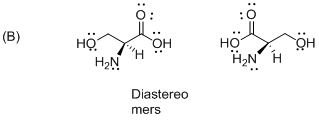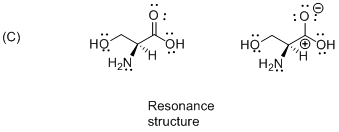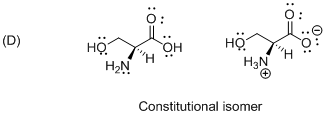
Concept explainers
(a)
Interpretation:
The given compound should be filled whether it is resonance structure, constitutional isomer, cis/trans isomer or same structure.
Concept introduction:
Isomer: Molecule has same molecular formula but different structural arrangement is called isomer.
Geometric isomerism (also known as E-Z isomerism or cis-trans isomerism): same molecular formula but different arrangement in the space. These isomers happen where you have restricted rotation in a molecule (double bond in the molecule). The
Constitutional isomer: (or structural) isomers differ in the connectivity they contain different functional groups and / or bonding patterns is called constitutional isomer.
Resonance: it is a process of delocalization electrons with in the molecule.
Chiral: Absence of a plane of symmetry or a center of symmetry is called chiral molecule, a non-superimposable on its mirror image is called chiral. A carbon atom is attached by the four different groups is called chiral carbon.
Enantiomers: Two stereoisomers that are mirror images of each other and they are non-supposable.
Diastereomers: Two stereoisomers that are non-mirror images of each other and they are non-supposable.
(a)
Answer to Problem 23.86QP
The given compound is diastereomers (a)
Explanation of Solution
To find: The given compound is resonance structure, constitutional isomer, cis/trans isomer or same structure
The given compound is resonance structure, constitutional isomer, cis/trans isomer or same structure needs to be known.
The given compound is diastereomers which is shown below.

The above compounds are non-mirror images of each other and they are non-supposable therefore the given compound diastereomers.
(b)
Interpretation:
The given compound should be filled whether it is resonance structure, constitutional isomer, cis/trans isomer or same structure.
Concept introduction:
Isomer: Molecule has same molecular formula but different structural arrangement is called isomer.
Geometric isomerism (also known as E-Z isomerism or cis-trans isomerism): same molecular formula but different arrangement in the space. These isomers happen where you have restricted rotation in a molecule (double bond in the molecule). The functional groups are same side in the molecule is cis, the functional groups are opposite side is called trans isomer.
Constitutional isomer: (or structural) isomers differ in the connectivity they contain different functional groups and / or bonding patterns is called constitutional isomer.
Resonance: it is a process of delocalization electrons with in the molecule.
Chiral: Absence of a plane of symmetry or a center of symmetry is called chiral molecule, a non-superimposable on its mirror image is called chiral. A carbon atom is attached by the four different groups is called chiral carbon.
Enantiomers: Two stereoisomers that are mirror images of each other and they are non-supposable.
Diastereomers: Two stereoisomers that are non-mirror images of each other and they are non-supposable.
(b)
Answer to Problem 23.86QP
The given compound is diastereomers (b)
Explanation of Solution
To find: The given compound is resonance structure, constitutional isomer, cis/trans isomer or same structure
The given compound is resonance structure, constitutional isomer, cis/trans isomer or same structure needs to be known.
The given compound is diastereomers which is shown below.

The above compounds are non-mirror images of each other and they are non-supposable therefore the given compound diastereomers.
(c)
Interpretation:
The given compound should be filled whether it is resonance structure, constitutional isomer, cis/trans isomer or same structure.
Concept introduction:
Isomer: Molecule has same molecular formula but different structural arrangement is called isomer.
Geometric isomerism (also known as E-Z isomerism or cis-trans isomerism): same molecular formula but different arrangement in the space. These isomers happen where you have restricted rotation in a molecule (double bond in the molecule). The functional groups are same side in the molecule is cis, the functional groups are opposite side is called trans isomer.
Constitutional isomer: (or structural) isomers differ in the connectivity they contain different functional groups and / or bonding patterns is called constitutional isomer.
Resonance: it is a process of delocalization electrons with in the molecule.
Chiral: Absence of a plane of symmetry or a center of symmetry is called chiral molecule, a non-superimposable on its mirror image is called chiral. A carbon atom is attached by the four different groups is called chiral carbon.
Enantiomers: Two stereoisomers that are mirror images of each other and they are non-supposable.
Diastereomers: Two stereoisomers that are non-mirror images of each other and they are non-supposable.
(c)
Answer to Problem 23.86QP
The given compound is resonance structure (c)
Explanation of Solution
To find: The given compound is resonance structure, constitutional isomer, cis/trans isomer or same structure
The given compound is resonance structure, constitutional isomer, cis/trans isomer or same structure needs to be known.
The given compound is resonance structure which is shown below.

Isomers have different sequence of bond types or connection in different order is called as resonance structure therefore the given molecule is resonance structure.
(d)
Interpretation:
The given compound should be filled whether it is resonance structure, constitutional isomer, cis/trans isomer or same structure.
Concept introduction:
Isomer: Molecule has same molecular formula but different structural arrangement is called isomer.
Geometric isomerism (also known as E-Z isomerism or cis-trans isomerism): same molecular formula but different arrangement in the space. These isomers happen where you have restricted rotation in a molecule (double bond in the molecule). The functional groups are same side in the molecule is cis, the functional groups are opposite side is called trans isomer.
Constitutional isomer: (or structural) isomers differ in the connectivity they contain different functional groups and / or bonding patterns is called constitutional isomer.
Resonance: it is a process of delocalization electrons with in the molecule.
Chiral: Absence of a plane of symmetry or a center of symmetry is called chiral molecule, a non-superimposable on its mirror image is called chiral. A carbon atom is attached by the four different groups is called chiral carbon.
Enantiomers: Two stereoisomers that are mirror images of each other and they are non-supposable.
Diastereomers: Two stereoisomers that are non-mirror images of each other and they are non-supposable.
(d)
Answer to Problem 23.86QP
The given compound is constitutional isomer (d)
Explanation of Solution
To find: The given compound is resonance structure, constitutional isomer, cis/trans isomer or same structure
The given compound is resonance structure, constitutional isomer, cis/trans isomer or same structure needs to be known.
The given compound is constitutional isomer which is shown below.

Isomers with the same order of connections and sequence of bond types, but which differ in the spatial arrangement of the atoms therefore the given molecule is called constitutional isomer
Want to see more full solutions like this?
Chapter 23 Solutions
CHEMISTRY:ATOMS FIRST-2 YEAR CONNECT
- Recognizing ampli Draw an a amino acid with a methyl (-CH3) side chain. Explanation Check Click and drag to start drawing a structure. X Carrow_forwardWrite the systematic name of each organic molecule: structure name × HO OH ☐ OH CI CI O CI OH OHarrow_forwardく Check the box under each a amino acid. If there are no a amino acids at all, check the "none of them" box under the table. Note for advanced students: don't assume every amino acid shown must be found in nature. COO H3N-C-H CH2 HO CH3 NH3 O CH3-CH CH2 OH Onone of them Explanation Check + H3N O 0. O OH + NH3 CH2 CH3-CH H2N C-COOH H O HIC + C=O H3N-C-O CH3- - CH CH2 OH Х 2025 McGraw Hill LLC. All Rights Reserved. Terms of Use | Privacy Center Accesarrow_forward
- Write the systematic name of each organic molecule: structure HO-C-CH2-CH3 O -OH CH3-CH2-CH2-CH2-CH2-C-OH CH3 CH3-CH-CH2-C-OH Explanation Check S namearrow_forwardtheres 2 productsarrow_forwardDraw the major product of this solvolysis reaction. Ignore any inorganic byproducts. + CH3CH2OH Drawing Q Atoms, Bonds and Rings OCH2CH3 || OEt Charges OH 00-> | Undo Reset | Br Remove Done Drag To Pan +arrow_forward
- Draw the major product of this SN1 reaction. Ignore any inorganic byproducts. CH3CO2Na CH3CO2H Drawing + Br Q Atoms, Bonds and Rings OAC Charges OH ОАс Na ဂ Br Undo Reset Remove Done Drag To Pan +arrow_forwardOrganic Functional Groups entifying positions labeled with Greek letters in acids and derivatives 1/5 ssible, replace an H atom on the a carbon of the molecule in the drawing area with a ce an H atom on the ẞ carbon with a hydroxyl group substituent. ne of the substituents can't be added for any reason, just don't add it. If neither substi er the drawing area. O H OH Oneither substituent can be added. Check D 1 Accessibility ado na witharrow_forwardDifferentiate between electrophilic and nucleophilic groups. Give examples.arrow_forward
- An aldehyde/ketone plus an alcohol gives a hemiacetal, and an excess of alcohol gives an acetal. The reaction is an equilibrium; in aldehydes, it's shifted to the right and in ketones, to the left. Explain.arrow_forwardDraw a Haworth projection or a common cyclic form of this monosaccharide: H- -OH H- OH H- -OH CH₂OHarrow_forwardAnswer the question in the first photoarrow_forward
 Chemistry: Principles and PracticeChemistryISBN:9780534420123Author:Daniel L. Reger, Scott R. Goode, David W. Ball, Edward MercerPublisher:Cengage Learning
Chemistry: Principles and PracticeChemistryISBN:9780534420123Author:Daniel L. Reger, Scott R. Goode, David W. Ball, Edward MercerPublisher:Cengage Learning Organic And Biological ChemistryChemistryISBN:9781305081079Author:STOKER, H. Stephen (howard Stephen)Publisher:Cengage Learning,
Organic And Biological ChemistryChemistryISBN:9781305081079Author:STOKER, H. Stephen (howard Stephen)Publisher:Cengage Learning, General, Organic, and Biological ChemistryChemistryISBN:9781285853918Author:H. Stephen StokerPublisher:Cengage Learning
General, Organic, and Biological ChemistryChemistryISBN:9781285853918Author:H. Stephen StokerPublisher:Cengage Learning Chemistry for Today: General, Organic, and Bioche...ChemistryISBN:9781305960060Author:Spencer L. Seager, Michael R. Slabaugh, Maren S. HansenPublisher:Cengage Learning
Chemistry for Today: General, Organic, and Bioche...ChemistryISBN:9781305960060Author:Spencer L. Seager, Michael R. Slabaugh, Maren S. HansenPublisher:Cengage Learning World of Chemistry, 3rd editionChemistryISBN:9781133109655Author:Steven S. Zumdahl, Susan L. Zumdahl, Donald J. DeCostePublisher:Brooks / Cole / Cengage Learning
World of Chemistry, 3rd editionChemistryISBN:9781133109655Author:Steven S. Zumdahl, Susan L. Zumdahl, Donald J. DeCostePublisher:Brooks / Cole / Cengage Learning





